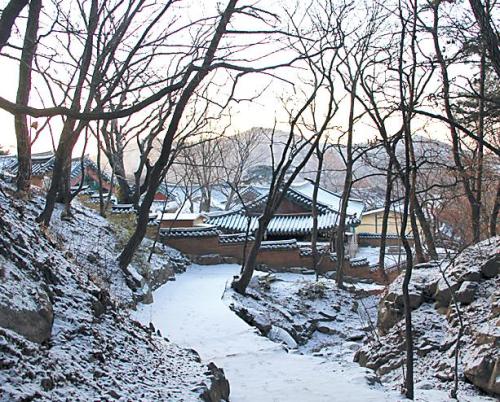One activity that always seems to make it on the to-do list of people planning a trip to Korea is taking part in a Templestay.
A Templestay at the historic Sudeoksa in South Chungcheong Province, however, is anything but average.
A temple two hours southwest of Seoul amongst the serene Deoksung Mountains, this 6th century national treasure is nestled in natural surroundings far from the hustle of city life.
The activities and rituals available to visitors are far different from the everyday experiences they are trying to escape.
You will be able to sit in on and take part in the awe-inspiring Buddhist chants that take place just after sunset and again before dawn.
The ceremony begins with the monks beating a huge drum, and ringing symbolic bells in the small meticulously painted shelters that surround the pagodas of the temple courtyard.
The sounds of this ceremony can be heard reverberating off the mountains that enclose the temple and echoing onto the plains below.
Time stands still as the monks complete the instrumental part of the ceremony and the place goes silent.
The Hall of Buddha then hosts the main part of the ceremony in which Buddhist chants are recited by the monks and the followers in complete and perfect unison.
The hall is a 704-year-old building housing three huge statues of Buddha and religious murals that line its walls.
 |
A narrow trail leads to Sudeoksa in the heart of the Deoksung Mountains in South Chungcheong Province. (Hamish Macdonald) |
Lit only by candlelight, the hall is an intimate and deeply religious place for Buddhists but will equally impress anyone who is able to take part in the processions.
If visiting in winter, you will see steam rising out of the monk’s mouths during the chants, which is a mesmerizing and deeply inspiring spectacle.
Being engulfed in the sounds and atmosphere of the temple is unlike anything you will experience outside.
This is just a small part of the entire Templestay that makes it a must-do for visitors to Korea.
Guests are able to speak to the monks who lead the orientation ceremony outlining the Buddhist way of life and the correct way to bow and meditate.
This will prove vital as you take part in the famous 108-bow ceremony.
Each visitor lines up with an individual kit in front of them, and with the guidance and timing of the monks, complete 108 full bows.
With each bow each person adds a new bead to their thread in this ritual of patience and endurance.
At first it sounds tiring, but as with much of the Buddhist practices you will be amazed by how your mind ignores the notion of time and with the therapeutic stringing of each bead you realize that you are in a state of complete calm.
The final result of the ceremony is yours to keep.
This ceremony is one of the several forms of meditation that people are able to practice during their stay.
Tracing images of Buddha or Buddhist texts as well as quiet sitting meditation will also rid the modern mind of the stresses of everyday life.
Traditional vegetarian temple food is served at mealtimes and during at least one of the meals you will be taught how Buddhist monks intricately make sure that they do not waste a single grain.
Sudeoksa is the home of many famous Buddhist teachers and has a special place in Korean Buddhism.
Due to its fame, the monks who are used to taking Korean-speaking guests are equally prepared for English speakers.
With advanced notice they can provide translators so that visitors can get the most out of their stay at the temple as well as group talks and instructions from senior monks.
Their wisdom and knowledge of Buddhism is one of the most memorable aspects of the stay.
The temple takes visitors at all times of the year and if guests don’t mind the cold the winter stays are beautiful with the temple buildings and surrounding mountains covered in snow.
You can sit in on Dharma talks, walk around the grounds and even climb Mount Deoksung for an incredible panoramic view of the largely rural surrounding areas.
You will hear the monks say that once you leave this temple you will feel very different from before.
They are not kidding.
By Hamish Macdonald (
hmac2115@uni.sydney.edu.au)








